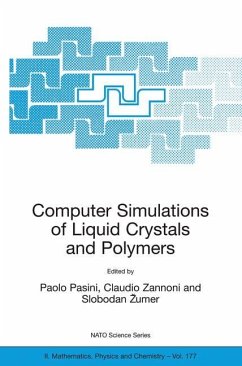
Soft Matter Physics
An Introduction
Mitarbeit: Friedel, J.
Versandkostenfrei!
Versandfertig in über 4 Wochen
306,99 €
inkl. MwSt.
Weitere Ausgaben:

PAYBACK Punkte
153 °P sammeln!
Traditionally, the materials studied by physicists have uniform properties and can readily be classified as solids, liquids, or gases. However, many materials of great interest for technology, chemistry, or biology, have complex structures and properties that vary from point to point and time to time. Among these are such materials as liquid crystals, polymer solutions or melts, colloids, foams, and gels, which have come collectively to be called "soft matter." They generally consist of organic molecules that interact weakly, so that individual phases are stable only over small temperature ranges.This text, intended for students with some knowledge of quantum mechanics, discusses the physics of these materials. It begins with discussions of the chemical bond and the interactions that bind molecules into condensed matter, of the ordering (crystalline or otherwise) one finds in condensed matter, noting that for soft matter the order is intermediate between that of crystals and that of typical disordered fluids. The discussion then turns to phase transitions, elasticity, and dynamics, using liquid crystals as the focus. A discussion of growth phenomena and fractals introduces a detailed treatment of dislocations and defects that clarifies many concepts by using insights only recently developed from the study of liquid crystals. The book concludes with discussions of surface phenomena, the stability of colloidal systems, and structural properties of polymers. The detailed exposition, the emphasis on physical principles, and the exercises at the ends of each chapter will make this a valuable introduction to this rapidly growing area of research.
Condensed Matter:
- General Characters, The Chemical Bond, Particle Interactions
- Atomic and Molecular Arrangements
- The Order Parameter: Amplitude and Phase
- Phase Transitions
- Elasticity of Mesomorphic Phases
- Dynamics of Isotropic and Anisotropic Fluids
- Fractals and Growth Phenomena
- Dislocations in Solids
- Plastic Relaxation
- Dislocations in Smectic and Columnar Phases
- Curvature Defects in Smectics and Columnar Phases
- Disclinations and Topological Point Defects. Fluid Relaxation
- Topological Theory of Defects
- Surface Phenomena
- Stability of Colloidal Systems
- Polymers: Structural Properties.
Condensed Matter:
- General Characters, The Chemical Bond, Particle Interactions
- Atomic and Molecular Arrangements
- The Order Parameter: Amplitude and Phase
- Phase Transitions
- Elasticity of Mesomorphic Phases
- Dynamics of Isotropic and Anisotropic Fluids
- Fractals and Growth Phenomena
- Dislocations in Solids
- Plastic Relaxation
- Dislocations in Smectic and Columnar Phases
- Curvature Defects in Smectics and Columnar Phases
- Disclinations and Topological Point Defects. Fluid Relaxation
- Topological Theory of Defects
- Surface Phenomena
- Stability of Colloidal Systems
- Polymers: Structural Properties.
Introductions to solid state physics have, ever since the initial book by F. Seitz in 1940, concentrated on simple crystals, with few atoms per cell, bonded together by strong ionic, covalent, or metallic bonds. References to weaker bonds, such as van der Waals forces in rare gases, or to geometric or chemical disorder (e.g., alloys or glasses) have been limited. The physical understanding of this ?eld started well before Seitz's book and led to a number of Nobel prizes after the last war. Applications cover classical metallurgy, el- tronics, geology and building materials, as well as electrical and ionic transport, chemical reactivity, ferroelectricity and magnetism. But in parallel with this general and well publicized trend, and sometimes earlier as far as physical concepts were concerned, an exploration and increasingly systematic study of softer matter has developed through the twentieth century. More often in the hands of physical chemists and crystallographers than those of pure physicists, the ?eld had for a long time a reputation of complexity. If progress in polymers was steady but slow, interest in liquid crystals had lain dormant for forty years, after a bright start lasting through 1925, to be revived in the late 1960s based on their possible use in imaging techniques. The optoelectronic properties of the ?eld in general are even more recent.












